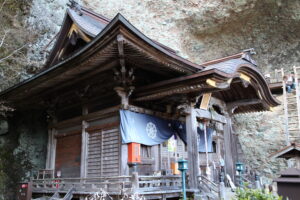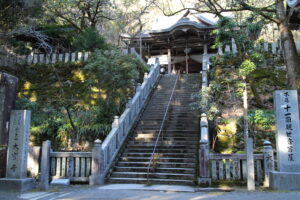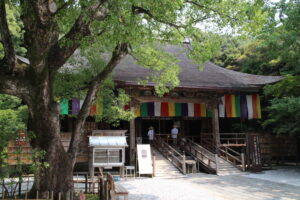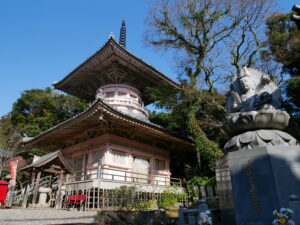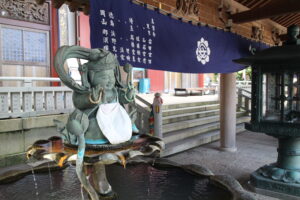Situated near Japan’s oldest hot spring in Matsuyama City, the legend of Ishite-ji, or Stone-Hand Temple, sits at the heart of the Henro.
Origins and History of Ishite-ji
Temple records hold that Ishite-ji was originally opened by the great saint Gyoki in 728, built to worship the deities of Kumano and named Anyo-ji.However, legend says that on one fateful day in the 9th century, a monk knocked on the front door of a rich, curmudgeonly farmer named Emon Saburo, begging for food. Emon, a notorious miser, told the monk to get lost every day for a week straight. When the monk showed up for an eight day, Emon grabbed a broom and whacked the monk’s begging bowl, which fell to the ground and broke into eight pieces. The monk bowed and quietly left, but over the next weeks, each of Saburo’s eight children died.Realizing he’d made a mistake, Emon asked his neighbors who the monk was. Shocked at his ignorance, they told him it was the renowned monk Kukai. Saburo immediately began circling the island of Shikoku, tracing Kukai’s footsteps in order to beg his forgiveness. After circling the island clockwise 20 times without finding Kukai, it occurred to Emon that he should go backwards and bump into Kukai that way. But the preceding journeys had taken all of Emon’s strength, and he collapsed near Shosan-ji, Temple 12. Just as he was about to die, Kukai appeared and hurried to Emon’s side. With the last of his strength, Emon rose to his knees and begged Kukai’s forgiveness. Kukai warmly accepted Emon’s apology and asked him where he wished to be reborn. Emon replied that he hoped to be reborn into his current clan, the Kono, so that he could be of more use to them the second time around. Kukai wrote “Emon Saburo Reborn” on a stone and pressed it into the weary pilgrim’s hand, and with that Emon breathed his last. Kukai buried him and planted his staff in the ground as a grave marker before continuing on his way.Some time later (temple records say 892), a baby boy was born to the Konos. The infant was beautiful and healthy…except that his hand was tightly closed, and no matter how hard his family tried they couldn’t pry it open. Distraught, they took the baby to Anyo-ji and asked the head priest to pray for his hand to heal. As soon as the priest began his chanting, the child’s hand snapped open and a stone fell to the floor…on which was written what else but, “Emon Saburo Reborn”! The overjoyed family offered the stone to the temple, and its name was changed to Ishite-ji.

What to See at Ishite-ji
As a prominent urban temple long patronized by the local Kono clan of seafaring warriors, Ishite-ji’s enormous grounds are packed with fascinating points of interest. The temple entrance features a stone tableau of Emon Saburo prostrating to Kobo Daishi in front of a long colonnade leading toward the temple’s main gate. The main gate, guarded by two exquisite Vajra Warriors, dates from 1318 and has been designated a National Treasure. Straight past the main gate up the steps is the main hall, which dates from around the same period. Past the main gate towers an impressive 3-story pagoda, built around the same time as the gate. Around the base of the pagoda are displayed containers filled with earth from all of the 88 temples, comprising a mini-pilgrimage much beloved by locals and pilgrims alike. Past the pagoda up the steps is the main hall, which also dates from the 14th-century. The Daishi-hall is to the right of the main hall. Around the Daishi hall are scattered stones inscribed with the names of babies born safely after parents offered prayers at the temple. Further on, the temple museum has the original Emon Saburo stone, along with a number of other fascinating artifacts, on display.

A Story That Still Lives in Stone
Ishite-ji’s vivid legends, layered history, and impressive architecture make it one of the most memorable stops on the Shikoku Pilgrimage. Whether you’re drawn by its connection to Emon Saburo’s redemption or its treasured temple buildings, it’s a site where the past still speaks. Shikoku Tours’ experienced guide-interpreters are ready to help you uncover the deeper meanings, navigate the legends, and make the most of your visit.


